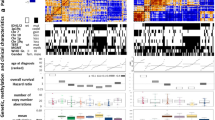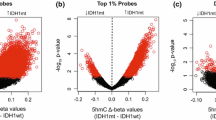Abstract
Glioblastoma (GBM) is the most malignant neoplasm with predominant astrocytic differentiation and the most frequent primary brain tumor of the adult. Here, we investigated 170 human GBM specimens deriving from 162 patients, as well as 66 healthy control tissue specimens deriving from 27 patients, and analyzed the amount of 5-hydroxymethylcytosine (5hmC) in GBMs compared to normal brain and tumor infiltration zones. Additionally, we correlated the amount of 5hmC with two different proliferation markers, Ki67 and H3S10p. Genetic characterization of GBMs enabled us to analyze the effect of isocitrate dehydrogenase 1 (IDH1) mutations, O6-methylguanin-DNA-methyltransferase (MGMT) promoter methylation, and loss of heterozygosity of chromosome 1p and 19q (LOH1p/19q) on 5hmC amount. We found that GBMs show a tremendous loss of 5hmC, and we observed that even the infiltration zones show reduced amounts of 5hmC. Interestingly, the amount of 5hmC was inversely proportional to the two investigated proliferation markers, Ki67 and H3S10p. Correlation of 5hmC amount and molecular genetic markers of GBMs showed that there are no correlations of 5hmC amount and IDH1 mutations, MGMT promoter methylation, and LOH1p/19q. Furthermore, we evaluated the intratumoral distribution of 5hmC in compact and infiltrating areas and found that the quantification of the 5hmC amount is a useful tool in evaluation of tumor infiltration. In summary, our data emphasize that GBMs show a disturbed hydroxymethylome that is disrupted by IDH1 independent pathways, and that loss of 5hmC shows astonishing intratumoral heterogeneity.



Similar content being viewed by others
References
Louis DN, Ohgaki H, Wiestler OD, Cavenee WK, Burger PC, Jouvet A, et al. The 2007 WHO classification of tumours of the central nervous system. Acta Neuropathol. 2007;114:97–109.
Crocetti E, Trama A, Stiller C, Caldarella A, Soffietti R, Jaal J, et al. Group Rw: epidemiology of glial and non-glial brain tumours in Europe. Eur J Cancer. 2012;48:1532–42.
Dolecek TA, Propp JM, Stroup NE, Kruchko C. CBTRUS statistical report: primary brain and central nervous system tumors diagnosed in the United States in 2005–2009. Neuro-Oncology. 2012;14 Suppl 5:v1–49.
Sottoriva A, Spiteri I, Piccirillo SG, Touloumis A, Collins VP, Marioni JC, et al. Intratumor heterogeneity in human glioblastoma reflects cancer evolutionary dynamics. Proc Natl Acad Sci U S A. 2013;110:4009–14.
Patel AP, Tirosh I, Trombetta JJ, Shalek AK, Gillespie SM, Wakimoto H, et al. Single-cell RNA-seq highlights intratumoral heterogeneity in primary glioblastoma. Science. 2014;344:1396–401.
Aubry M, de Tayrac M, Etcheverry A, Clavreul A, Saikali S, Menei P, et al. From the core to beyond the margin: a genomic picture of glioblastoma intratumor heterogeneity. Oncotarget. 2015.
Kraus TF, Globisch D, Wagner M, Eigenbrod S, Widmann D, Munzel M, et al. Low values of 5-hydroxymethylcytosine (5hmC), the “sixth base,” are associated with anaplasia in human brain tumors. Int J Cancer J Int du Cancer. 2012;131:1577–90.
Kriaucionis S, Heintz N. The nuclear DNA base 5-hydroxymethylcytosine is present in Purkinje neurons and the brain. Science. 2009;324:929–30.
He YF, Li BZ, Li Z, Liu P, Wang Y, Tang Q, et al. TET-mediated formation of 5-carboxylcytosine and its excision by TDG in mammalian DNA. Science. 2011;333:1303–7.
Ito S, Shen L, Dai Q, Wu SC, Collins LB, Swenberg JA, et al. TET proteins can convert 5-methylcytosine to 5-formylcytosine and 5-carboxylcytosine. Science. 2011;333:1300–3.
Pfaffeneder T, Hackner B, Truss M, Munzel M, Muller M, Deiml CA, et al. The discovery of 5-formylcytosine in embryonic stem cell DNA. Angew Chem. 2011;50:7008–12.
Spruijt CG, Gnerlich F, Smits AH, Pfaffeneder T, Jansen PW, Bauer C, et al. Dynamic readers for 5-(hydroxy)methylcytosine and its oxidized derivatives. Cell. 2013;152:1146–59.
Dongol S, Thompson CN, Clare S, Nga TV, Duy PT, Karkey A, et al. The microbiological and clinical characteristics of invasive salmonella in gallbladders from cholecystectomy patients in Kathmandu, Nepal. PLoS One. 2012;7, e47342.
Wu H, D’Alessio AC, Ito S, Wang Z, Cui K, Zhao K, et al. Genome-wide analysis of 5-hydroxymethylcytosine distribution reveals its dual function in transcriptional regulation in mouse embryonic stem cells. Genes Dev. 2011;25:679–84.
Wu H, D’Alessio AC, Ito S, Xia K, Wang Z, Cui K, et al. Dual functions of TET1 in transcriptional regulation in mouse embryonic stem cells. Nature. 2011;473:389–93.
Yildirim O, Li R, Hung JH, Chen PB, Dong X, Ee LS, et al. Mbd3/NURD complex regulates expression of 5-hydroxymethylcytosine marked genes in embryonic stem cells. Cell. 2011;147:1498–510.
Mellen M, Ayata P, Dewell S, Kriaucionis S, Heintz N. MeCP2 binds to 5hmC enriched within active genes and accessible chromatin in the nervous system. Cell. 2012;151:1417–30.
Thon N, Eigenbrod S, Grasbon-Frodl EM, Lutz J, Kreth S, Popperl G, et al. Predominant influence of MGMT methylation in non-resectable glioblastoma after radiotherapy plus temozolomide. J Neurol Neurosurg Psychiatry. 2011;82:441–6.
Thon N, Eigenbrod S, Grasbon-Frodl EM, Ruiter M, Mehrkens JH, Kreth S, et al. Novel molecular stereotactic biopsy procedures reveal intratumoral homogeneity of loss of heterozygosity of 1p/19q and TP53 mutations in World Health Organization grade II gliomas. J Neuropathol Exp Neurol. 2009;68:1219–28.
Hegi ME, Diserens AC, Gorlia T, Hamou MF, de Tribolet N, Weller M, et al. MGMT gene silencing and benefit from temozolomide in glioblastoma. N Engl J Med. 2005;352:997–1003.
Stupp R, Mason WP, van den Bent MJ, Weller M, Fisher B, Taphoorn MJ, et al. European Organisation for R, Treatment of Cancer Brain T, Radiotherapy G, National Cancer Institute of Canada Clinical Trials G: radiotherapy plus concomitant and adjuvant temozolomide for glioblastoma. N Engl J Med. 2005;352:987–96.
Stupp R, van den Bent MJ, Hegi ME. Optimal role of temozolomide in the treatment of malignant gliomas. Curr Neurol Neurosci Rep. 2005;5:198–206.
Stupp R, Hegi ME, Mason WP, van den Bent MJ, Taphoorn MJ, Janzer RC, et al. European Organisation for R, Treatment of Cancer Brain T, Radiation Oncology G, National Cancer Institute of Canada Clinical Trials G: effects of radiotherapy with concomitant and adjuvant temozolomide versus radiotherapy alone on survival in glioblastoma in a randomised phase III study: 5-year analysis of the EORTC-NCIC trial. Lancet Oncol. 2009;10:459–66.
Knisely JP, Baehring JM. A silver lining on the horizon for glioblastoma. Lancet Oncol. 2009;10:434–5.
Intergroup Radiation Therapy Oncology Group T, Cairncross G, Berkey B, Shaw E, Jenkins R, Scheithauer B, et al. Phase III trial of chemotherapy plus radiotherapy compared with radiotherapy alone for pure and mixed anaplastic oligodendroglioma: intergroup radiation therapy oncology group trial 9402. J Clin Oncol Off J Am Soc Clin Oncol. 2006;24:2707–14.
Jansen NL, Schwartz C, Graute V, Eigenbrod S, Lutz J, Egensperger R, et al. Prediction of oligodendroglial histology and LOH1p/19q using dynamic [(18)F]FET-PET imaging in intracranial WHO grade II and III gliomas. Neuro-Oncology. 2012;14:1473–80.
Torp SH. Proliferative activity in human glioblastomas: evaluation of different Ki67 equivalent antibodies. Mol Pathol. 1997;50:198–200.
Torp SH. Diagnostic and prognostic role of Ki67 immunostaining in human astrocytomas using four different antibodies. Clin Neuropathol. 2002;21:252–7.
Ribeiro-Mason K, Boulesteix C, Fleurot R, Aguirre-Lavin T, Adenot P, Gall L, et al. H3S10 phosphorylation marks constitutive heterochromatin during interphase in early mouse embryos until the 4-cell stage. J Reprod Dev. 2012;58:467–75.
Szulwach KE, Li X, Li Y, Song CX, Wu H, Dai Q, et al. 5-HMC-mediated epigenetic dynamics during postnatal neurodevelopment and aging. Nat Neurosci. 2011;14:1607–16.
Xu W, Yang H, Liu Y, Yang Y, Wang P, Kim SH, et al. Oncometabolite 2-hydroxyglutarate is a competitive inhibitor of alpha-ketoglutarate-dependent dioxygenases. Cancer Cell. 2011;19:17–30.
Kunimoto H, Fukuchi Y, Sakurai M, Takubo K, Okamoto S, Nakajima H. TET2-mutated myeloid progenitors possess aberrant in vitro self-renewal capacity. Blood. 2014;123:2897–9.
Nakajima H, Kunimoto H. TET2 as an epigenetic master regulator for normal and malignant hematopoiesis. Cancer Sci. 2014;105:1093–9.
Acknowledgments
The authors thank the BrainBank Munich (Thomas Arzberger) for providing control tissue.
Funding
None.
Conflict of interest
None.
Author information
Authors and Affiliations
Corresponding author
Electronic supplementary material
Below is the link to the electronic supplementary material.
Supplementary Fig. S1
Molecular genetic status of investigated GBMs. We analyzed MGMT promoter methylation status (a), IDH1/2 mutation status (b), and LOH1p/19q status (c) of tumors. MGMT methylation: 0, unmethylated MGMT promoter sequence; 1, methylated MGMT promoter sequence; 2, partially methylated MGMT promoter sequence; 9, not determined due to tissue limitations. IDH mutations: 0, IDH1 no mutation and IDH2 no mutation; 1, IDH1 mutation and IDH2 no mutation; 2, IDH1 no mutation and IDH2 mutation; 3, IDH1 mutation and IDH2 mutation; 9, not determined due to tissue limitations. LOH1p/19q: 0, no LOH1p/19q; 1, loss of 1p; 2, loss of 19q: 3, LOH1p/19q; 4, other aberrations; 9, not determined due to tissue limitations. (TIFF 444 kb)
Supplementary Table S1
Overview of GBM patients. We investigated solid tumor regions of 162 GBMs as well as 10 tumor infiltration regions. Mean age of GBM patients was 59 years with a median age of 62 years. Sixty-four percent of patients were male and 36 % were female with a male to female ratio of 1.7. Details on the molecular genetic status of GBM can be found in Supplementary Fig. S1. (XLSX 17 kb)
Supplementary Table S2
Overview of control patients. Sixty-six control tissues derived from 27 different patients were investigated. Mean age of controls was 62 years with a median age of 61 years. Sixty-three percent of patients were male and 37 % were female with a male to female ratio of 1.7. n.a. not available. (XLSX 14 kb)
Rights and permissions
About this article
Cite this article
Kraus, T.F.J., Kolck, G., Greiner, A. et al. Loss of 5-hydroxymethylcytosine and intratumoral heterogeneity as an epigenomic hallmark of glioblastoma. Tumor Biol. 36, 8439–8446 (2015). https://doi.org/10.1007/s13277-015-3606-9
Received:
Accepted:
Published:
Issue Date:
DOI: https://doi.org/10.1007/s13277-015-3606-9




